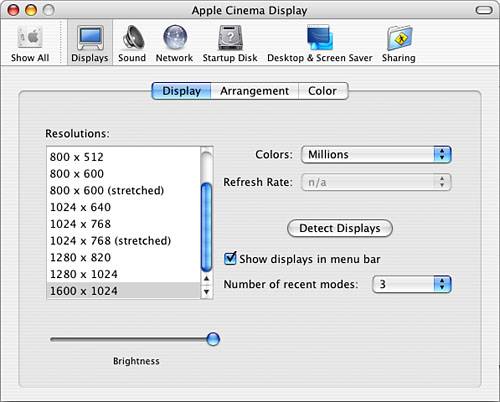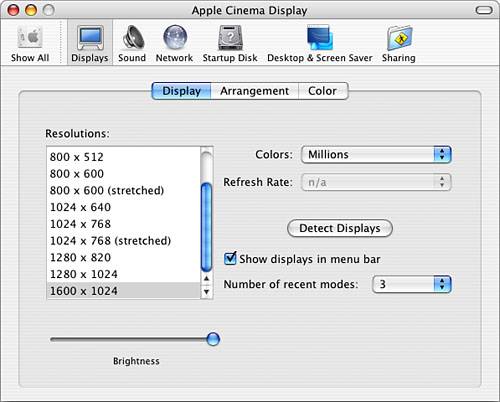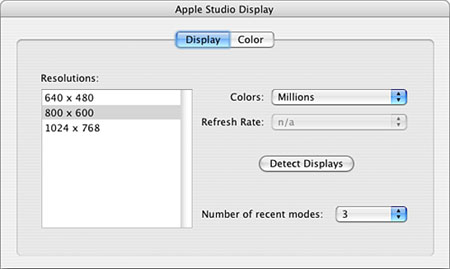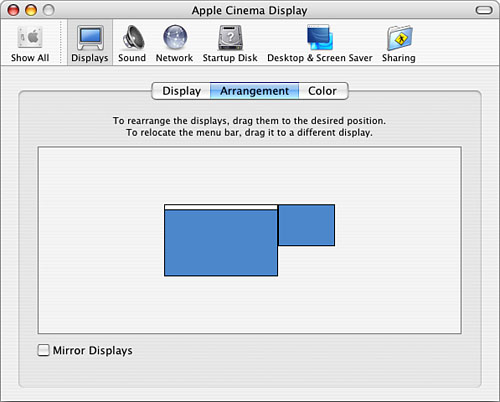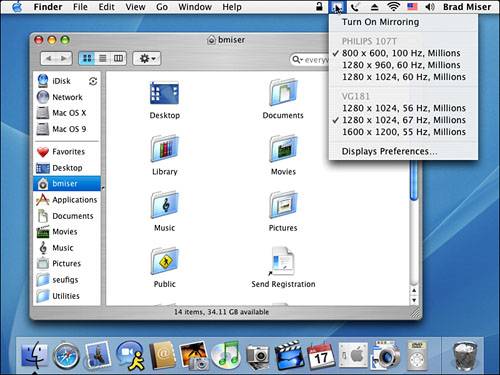Finding, Installing, and Using Speakers
Finding, Installing, and Using a MonitorNext to your Mac itself, your monitor might be the most important element of your system. Having the correct type and size of monitor can make working with your Mac more efficient and more enjoyable. Choosing a MonitorThe fundamental factors you need to take into account when choosing a monitor are detailed in the following sections. Display TypeThere are two options in the way a monitor displays information. With a cathode-ray tube (CRT) monitor, information appears on the screen as the result of an electron gun spraying electrons against the inside of the monitor screen, which is covered with phosphors that glow when struck by those electrons. The other choice is a liquid crystal display (LCD), which uses a liquid-based display medium. This technology enables the viewing area to be very thin and light, which is why all laptops are equipped with LCDs. The image quality of both types of displays is very good. Until recently, the cost of LCDs prevented their use except where nothing else would work because of size limitations, such as in a laptop. Recently, the cost of LCD monitors has decreased, so you can now purchase affordable LCD monitors for desktop machines as well. LCD monitors offer many benefits over CRTs. One is their size and weight; a comparably sized LCD display is much smaller and lighter than a CRT monitor. And a high-quality LCD monitor has a sharper and more vibrant picture than its CRT cousin. Because of these reasons, LCD monitors now dominate the computer landscape, so much so that the eMac is the only production Mac that features a CRT. All the monitors Apple produces are now LCDs. Unless you really need to spend the least amount of money possible, you should only consider LCD displays for your system. That is, unless you use a Mac whose external monitor support is limited to VGA output, in which case a CRT display can make sense. Being limited to VGA does not limit you to a CRT; some LCD monitors offer VGA ports. Display SizeDisplay size might be the single most important factor when considering a monitor. Various sizes of display area are available. The most common CRT monitor sizes are 15'', 17'', 19'', and 21''. Common LCD monitor sizes are 15'', 17'', and 18'' along with Apple's spectacular Cinema Displays, which come in a 17'' and 20'' and a 23'' high-definition model. When it comes to display size, bigger is better. You should get a quality monitor in the largest size you can afford because more display space yields more working area. Interface TypeOn modern Macs, there are three interfaces to which you connect a monitor: VGA, DVI, and Apple Display Connector (ADC). Various Mac models provide different types of video interface ports. For example, many Power Mac G4s and Power Mac G5s have an ADC and a DVI port on their built-in AGP graphics card. Some models with built-in monitors support external VGA monitors along with their built-in displays (flat panel LCD in the case of PowerBooks, iBooks, and iMacs; CRT in the case of the eMac). Regardless of a machine's built-in ports, using adapters, you can connect other types of monitors to them as well.
All these interface types provide excellent image quality, and each offers its own benefits. The primary benefit of VGA is that it was the standard interface for PC monitors, so you can use almost any CRT monitor with your Mac. The Digital Video Interface (DVI) offers superior digital signal quality and direct interface to many types of flat-panel displays. Among the benefits of ADC is that it is a digital signal and an Apple ADC display offers other features, such as including two additional USB ports, requiring only one cable (from the Mac to the monitor), and enabling you to power up your Mac and make it sleep or wake up. TIP If you use an Apple ADC monitor (one of its flat-panel displays), you can power up your Mac by pressing the Power button on the monitor and put your Mac to sleep by pressing the Power button again. Press the Power button while your Mac sleeps, and it will wake up. Dot PitchOn CRT monitors, the electron gun sprays electrons on a metallic grid on the inside of the glass. The smaller the distance between the holes in this grid is, the finer an image the monitor can display. Monitors with smaller pitches are better than those with larger pitches, all other things being equal. Typical pitch sizes range from .24mm to .28mm. Dot pitch is not applicable to flat-panel displays. Picking a DisplayChoosing a monitor can be difficult because of the number of choices that are available. However, you can use several factors to quickly narrow down the options to a few monitors that meet your criteria. First, decide how much you can afford to spend. You can spend as little as $100 for a 14'' CRT to around $1,999 for the top-of-the-line Apple Cinema HD Display. Second, decide whether you want a CRT or an LCD display. If you use a newer Power Mac G4 or a Power Mac G5 or own another model and can afford to spend a bit more, I strongly recommend that you consider an LCD display. In addition to the size and weight advantages, the display quality of some of the LCDs is amazing. Additionally, many offer special features such as additional ports. Third, choose the largest size in a quality brand of the type you choose that fits your budget. NOTE The monitor issue is not just for Power Mac G4 or Power Mac G5 users to consider. All modern Macs that include a built-in monitor have a DVI or VGA output port. For example, you can connect a monitor to an iMac's VGA port to use an external monitor with it. The image you see is the same as that shown on the iMac's internal display, but you can use a larger monitor that way, or you can show the same image to several people at the same time (such as for a presentation). NOTE Before you invest in an Apple flat-panel display, make sure your Mac supports the ADC interface. Some of the earliest Power Mac G4 machines don't. I hate to sound like a commercial here, but Apple's displays are the best available. If you have a Mac with the ADC interface, you should really consider either the flat-panel 17'' Apple Studio Display or one of the Apple Cinema Displays, which are the largest flat-panel screens available that use the ADC interface. Although the 17'' version might seem sort of small, its amazing clarity and brightness more than make up for giving up a bit of screen real estate. Additionally, the Apple Cinema Displays are magnificent. Currently, I have the 22'' cinema display and an older 15'' Studio display (no longer produced) connected to my Power Mac G4. For the maximum in size and image quality, consider the 23'' Cinema HD display that supports high-definition output. NOTE Some Macs, such as the iMac, require an adapter to be capable of connecting a VGA monitor to its video output port. Apple has converted its entire monitor line to LCD displays, so that is clearly the future for Mac users. The only machine Apple currently produces that uses CRTs is the eMac. Installing a MonitorInstalling a monitor requires two steps. First, connect the appropriate cables to the monitor and the Mac (in the case of ADC displays, only one cable is required). Second, install any software that was provided with the monitor. Some monitors include a ColorSync profile; if yours does, you should install and use it. If you are adding a second monitor to your Mac and have to install an additional graphics card, the graphics card you install might also have software that provides its special features.
NOTE You can find an adapter to enable you to attach almost any type of display to almost any type of video port. For example, some Power Mac G4s include two video output ports. One is ADC, whereas the other is DVI. If you want to connect an Apple ADC display to both ports, you need a DVI/ADC adapter. Configuring a MonitorAfter you have installed a monitor, use the Displays pane of the System Preferences utility to configure it. If you use a single monitor, this pane has two tabs Display and Color. If you use multiple monitors, the pane also includes the Arrangement tab (see Figure 23.1). You use the Display tab to configure the resolution, color depth, refresh rate, and brightness of the display. The specific options you have depend on the graphics card and monitor you are using. In any case, use the menus, sliders, pop-up menus, and other controls to configure the display. Generally, you should use the highest resolution that is comfortable for you to view. Then, choose the largest color depth and highest refresh rate that are supported at that resolution. Finally, set the brightness to a comfortable level for you. Figure 23.1. The Display pane of the System Preferences utility for an Apple 20'' cinema display; the Arrangement tab indicates that this machine is using multiple monitors.
Setting the resolution of a display is a matter of personal preference, but generally you can tolerate higher resolutions on larger monitors. For example, on the 21'' Apple Cinema Display, a resolution of 1600x1024 is comfortable for many people. On smaller monitors, 1024x768 might be appropriate. The resolution also depends on the sharpness and clarity of the display. For example, on the Apple 17'' flat-panel, a resolution of 1024x768 is very comfortable, but that same resolution might not be comfortable on a lower-quality CRT display. Because your Mac can resize the resolution on-the-fly (you don't have to restart), trying different resolutions to see which works best for you is easy. The trade-off is between more screen space at higher resolutions versus everything appearing smaller. Find the best fit for the type of data you work with and your eyesight. Some monitors support a "stretched" resolution, such as 1024x768 (stretched). This takes the standard 1024x768 resolution and "stretches" pixels in the horizontal direction so the image fills a widescreen display. (If you use a nonstretched resolution on these displays, black vertical bars appear on each side of the screen.) NOTE The "standard" resolution for Macs has continued to increase along with the size and clarity of monitors. For most of the Mac's early life, the standard display resolution was 640x480 (which also happens to be the resolution of non-HD television by the way). When Macs included larger screens and bigger monitors became available, this increased to 800x600. Currently, the minimum resolution you will likely use on most displays is 1024x768. In fact, some applications won't even run at 800x600 or less. After you have selected a resolution, select the color depth on the Colors pop-up menu. In almost all cases, you should select Millions. However, if you use an older graphics card and display, you might have to settle for Thousands. If you use a CRT, select the highest refresh rate available on the Refresh Rate pop-up menu. Using higher refresh rates makes the image flicker less and results in less strain on your eyes. NOTE If you use an Apple or other flat-panel display, the Refresh Rate pop-up menu is grayed out because refresh rate isn't applicable to these displays. If you want your Mac to detect the ADC displays you have attached to it, click the Detect Displays button. The name shown at the top of the System Preferences application and each Display settings dialog box (there will be one for each monitor) should identify the display you are using. (This button does not appear when you are using other types of displays.) Use the "Show displays in menu bar" check box to turn on the Displays menu in the menu bar. You can configure a display, such as setting its resolution, by selecting the resolution you want to use from the Displays menu. If you display this menu, use the "Number of recent modes" pop-up menu on the Display pane of the System Preferences application to set the number of resolution settings to display on the menu. For example, if you select 3 on this pop-up menu, the Displays menu on the menu bar shows the most recent three settings you have selected. This makes changing among your most commonly used resolution settings even easier. Some monitors support software brightness controls, in which case you will see a Brightness slider on the Displays pane. If you don't see this, use the display's physical controls to set its brightness (and contrast, if applicable).
After you have configured the Display tab, use the Color tab to select a ColorSync profile for your display.
Installing and Using a Second MonitorTo create the ultimate amount of desktop working space, consider adding multiple monitors to your system. With the Mac OS, you have always been able to have two or more monitors working at the same time, with each monitor displaying different portions of the desktop. For example, you can display a document on which you are working on one monitor and all the toolbars and palettes you are using on a second. Or you might want to have a document open on one screen and your email application open on the other. NOTE Most Power Mac G4 and all Power Mac G5 models offer support for multiple monitors out of the box. These machines include an ADC port and a DVI port on the AGP graphics card so you can connect one of each type of monitor to take advantage of multiple monitors. You can also use a DVI/ADC adapter to attach two ADC displays to the same machine. All you need to do is add the second display (and an adapter if needed), and you are good to go. To have multiple monitors installed on a machine without out-of-the-box multiple monitor support or to add even more monitors to a machine that already supports multiple monitors, you need to install a PCI or PCI-X graphics card for each monitor. NOTE Modern Power Mac G4s and Power Mac G5s feature an accelerated graphics port (AGP) slot in which the preconfigured graphics card is installed. This slot offers the greatest video performance and is where the RADEON or NVIDIA graphics card is installed. When you add a second monitor, you install additional graphics cards in the PCI or PCI-X slots that are available. Because only one AGP slot exists, you aren't able to achieve the same level of performance from the video cards installed in the PCI slots. However, you can still achieve very good performance with PCI- or PCI-X-based graphics cards. And you can always configure your system so you work with applications and documents that require the maximum performance on the displays that use the AGP slot. You can use the other displays for less graphics-intensive applications. Choosing a PCI or PCI-X Graphics CardMany graphics cards are available, each offering differing levels of performance and special features. When choosing a graphics card, consider the following factors:
NOTE You can also replace the default AGP video card in your Mac with one that offers better performance. Just make sure that the card you get is compatible with your Mac. Replacing the AGP card is similar to installing a PCI or PCI-X card. Installing a Graphics CardInstalling a PCI or PCI-X graphics card is a relatively easy process. CAUTION The following steps are an example of how a typical graphics card is installed on a Power Mac G4. You should follow the instructions that came with your Mac and the graphics card you are adding. NOTE If software is provided for the card, such as drivers and applications, you should install the software before you install the card. However, check with the instructions that came with the card to see the order in which the manufacturer recommends the items be installed. To install a new or additional graphics card, do the following:
Working with Two (or More) MonitorsIf you have installed an additional graphics card and connected it to a monitor or you have a Mac that supports multiple monitors, you need to configure the displays to work together. When you have more than one monitor installed, one of the monitors must be the primary monitor. This is the monitor on which the menu bar, Dock, mounted volumes, and other desktop items are displayed. The rest of the monitors contain windows that you place on them. To display items on more than one monitor, do the following:
Because the desktop stretches across all the monitors connected to your system, they act as one large desktop. You can drag windows and palettes from one monitor to another by moving them from one side of the desktop to the other. You can move between the monitors by moving the pointer "across" the divide between them. For example, you might have an image open in Photoshop on one monitor and all the Photoshop palettes on the other. Or, you can have a Word document open on one monitor and a Web browser on another. After you use multiple monitors for even a short time, you might find that you can never get along with just one again. NOTE You can drag windows between the monitors, but the menu bar, Dock, and other desktop items always remain on the primary display. You can have multiple monitors display the same image by turning on display mirroring. In this case, each monitor displays the same desktop. You are limited to the same amount of working space, but that same space is displayed on multiple displays. This is especially useful when you connect a projector to one video port and use a display on the other. You can work using the display while the audience sees what you are doing via the projected image. To configure mirroring, set the monitors to the same resolution. In the Arrange tab of the Display pane, check the Mirror Displays check box. All monitors connected to the machine then display the same image. NOTE If you connect a display or projector to the VGA or DVI port on a PowerBook, iBook, iMac, or eMac, you can only use video mirroring. If you add the Displays menu to your menu bar, you can control display mirroring, the resolution, and the color depth of each monitor by choosing the setting you want on the menu. You can also open the Displays pane of the System Preferences utility from the menu (see Figure 23.5). Figure 23.5. Control the resolution and other settings of all the displays attached to your Mac from the Displays menu in the Mac OS X menu bar.
|
EAN: 2147483647
Pages: 273
 To learn more about video interfaces,
To learn more about video interfaces, 